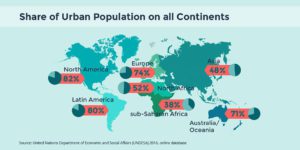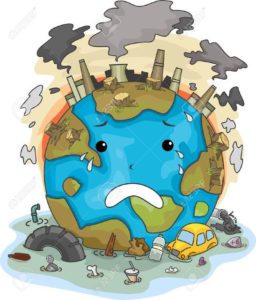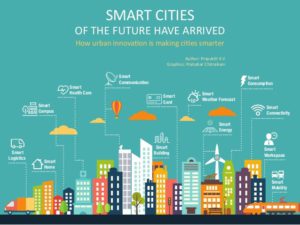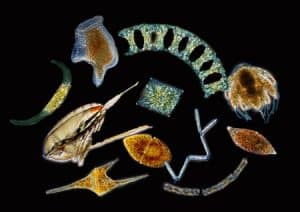For the last six decades, humans and human activities have been moving from rural settlements to cities in a process called urbanization. Since 1950, the world’s urban population has grown rapidly, from 746 million to 3.9 billion in 2014. At the same time, population density in some of those areas has been increasing at a similar rate. Although cities account for only two per cent of global land area, they hosted, according to a recent report from the United Nations [1], an estimated 54.5% of the world’s population in 2016. This report also projected that by 2030, urban areas will house 60% of people globally and that one in every three people will live in cities with at least half a million inhabitants.

While cities can entail numerous advantages (i.e. more concentrated and consequently more effective communication, sanitation and transportations systems), negative consequences linked to the urbanization process also arise. Cities are centres of human activity and therefore, hotspots of pollutant emissions: atmospheric and noise pollution due to traffic congestion, water pollution due to the generation of bigger amounts of wastewater, generation of bigger volumes of solid waste, etc. Links between the presence pollution and the appearance of respiratory, mental and cardiovascular diseases have already been made [2], [3], as well as a relationship cause-effect on premature death. The World Health Organization estimated, in a recent report published in 2017, that 1.7 million child deaths are due to exposure to polluted environments [4]. With the projected trends on urbanization and urban population growth, waste and pollution issues arising from cities are becoming more important [5]. For that reason, it is essential to develop new tools to monitor those problems and keep urban planners and regulators informed so that pollution issues can be tackled more effectively.

Cities are like living systems in permanent activity and constant change, they require energy and resources and they generate all sorts of waste that needs handling. In developed countries, for example, a new concern has risen with the appearance of what have been called emerging pollutants (Eps) [6]. Eps are chemical substances (of natural or synthetic origin) that are not commonly monitored, but that have the potential to enter the environment and cause adverse ecological or human health effects. They can be new substances used in new technological developments (ie. novel materials such as engineered nanoparticles), substances that have been around for a long time without previous monitorization (i.e. microplastics) or previously undetectable in the environment due to analytical limitations (i.e pharmaceutical residues).

To investigate the potential health and environmental risks of the Eps, it is essential to understand their emissions. However, their quantification is particularly challenging in metropolitan areas due to the urban complexity and the analytical limitations for their detection in complex environmental samples. In this context, mathematical models emerge as powerful tools to estimate EPs emissions rates and environmental concentrations and provide scenario assessments. Models are conceptual simplifications of the reality that use mathematical and statistical tools to simulate real life processes. In this sense, a model could estimate emissions rates of specific pollutants by understanding the processes under which they are released into the environment.
For example, in the project I am currently working for my PhD studies in the University of York, we are developing mathematical models that help predict the current and future emissions and exposure of engineered nanoparticles in cities [7]. Engineered nanoparticles are currently used in a wide variety of products (from cosmetics, clothes, electronic devices to fuel additives and many others) and the nanotechnology market is on the rise. Therefore, there is an urgent need to understand the environmental implications of their increasing emissions to air, water and soil [8]. The study of the life cycle of the products containing those EPs (from production, transport, usage until disposal) together with data gathered on the market flows of those products, allow models to simulate such processes and to generate predictions on their emission rates.
Furthermore, in an increasingly data driven society, where consumers data is constantly being gathered (through new mobile phone applications), and where al shorts of sensors are being displayed around the cities, models could become the new technologies needed to assess, control and mitigate pollution in a cheaper and more effective way. Cities are becoming smarter in many ways and pollution monitoring and mitigation should be on the equation.
By Prado Domeneq PhD Student. Marie Curie Early Stage Researcher Environment Department University of York, SRUK Yorkshire Constituency
More info:
United nations sustainable development goals, Goal 11: Sustainable cities and communities: http://www.undp.org/content/undp/en/home/sustainable-development-goals/goal-11-sustainable-cities-and-communities.html
Key Urban Environmental Problems: http://web.mit.edu/urbanupgrading/urbanenvironment/issues/key-UE-issues.html
[1]http://www.un.org/en/development/desa/population/publications/pdf/urbanization/the_worlds_cities_in_2016_data_booklet.pdf
[2] Kelly, F.J. and Fussell, J.C., 2015. Air pollution and public health: emerging hazards and improved understanding of risk. Environmental geochemistry and health, 37(4), pp.631-649.
[3] Stansfeld, S.A., 2015. Noise effects on health in the context of air pollution exposure. International journal of environmental research and public health, 12(10), pp.12735-12760.
[4] http://www.who.int/mediacentre/news/releases/2017/pollution-child-death/en/
[5] McMichael, A.J., 2000. The urban environment and health in a world of increasing globalization: issues for developing countries. Bulletin of the World Health Organization, 78(9), pp.1117-1126.
[6] Geissen, V., Mol, H., Klumpp, E., Umlauf, G., Nadal, M., van der Ploeg, M., van de Zee, S.E. and Ritsema, C.J., 2015. Emerging pollutants in the environment: a challenge for water resource management. International soil and water conservation research, 3(1), pp.57-65.
[7] Domercq, P., Praetorius, A. and Boxall, A.B., 2018. Emission and fate modelling framework for engineered nanoparticles in urban aquatic systems at high spatial and temporal resolution. Environmental Science: Nano.
[8] Rickerby, D.G. and Morrison, M., 2007. Nanotechnology and the environment: A European perspective. Science and Technology of Advanced Materials, 8(1-2), pp.19-24.






